
Does Coffee Have An Umami Taste? Answered!
Coffee is one of the most popular drinks in the world. The taste profile of coffee is usually associated with the four “basic tastes”: sweet,
Thinking of coffee trends in waves is generally attributed to Trish Rothgreb of Wrecking Ball Coffee Roasters. Way back in 2002, Rothgreb wrote an article for The Flamekeerper, a newsletter of the Roasters Guild about the different waves of coffee. Many others have written about it since, and let me warn you: it quickly becomes blurry.
But the TLDR version is: the three waves of coffee are three periods in the history of coffee since the first half of the 20th century. It starts with a period where coffee becomes a commodity in stead of a luxury, and end with the current period in which there is a trend towards artisanal specialty coffee.
But of course, there is more to it.
Let’s dive bit deeper.
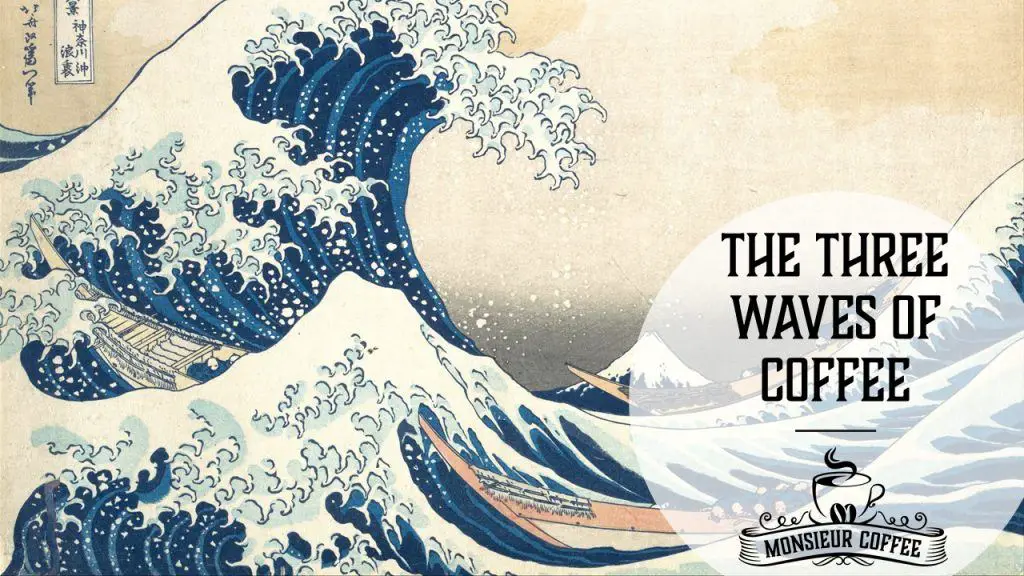
The first wave of coffee is a period in the first half of the 20th century where coffee is transformed from a luxury good into a commodity. Before this period, coffee was reserved for the well-off only.
Coffee, as many items during this period, starts to be produced on a larger scale. As a result, prices drop, and more people can afford to drink coffee. This comes at the expense of quality, though, and affordability and availability take priority over taste.
Two innovations at the start of the 20th century drive this wave: vacuum packaging and instant coffee. Vacuum packaging of coffee was introduced by the Hills Brothers. They were the first to remove all air from coffee tins. This, in theory, resulted in fresher coffee. However, it resulted in longer shelf life and the disappearance of local coffee roasters, and the rise of large coffee brands.
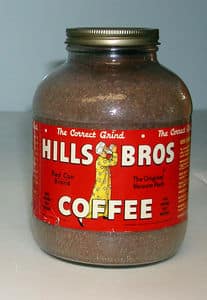
Instant coffee was in 1903 by Japanese-American Satori Kato. He also developed a dehydration process that resulted in soluble tea and applied this process to coffee. It was the perfect product for a quickly modernizing world. Frozen dinners and instant coffee made life quick and easy. And as instant coffee doesn’t require ant brewing equipment, it (Maxwell House Instant Coffee) was perfect for the soldiers going off to fight in World War I.
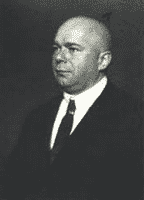
A little over three decades later, in 1938, Nescafe instant coffee was so popular that they supply the U.S. military with coffee for their soldiers fighting in World War II. And the popularity didn’t stop with soldiers or with the end of the war. In the 1970s, almost one-third of all coffee imported into the U.S. was used to produce instant coffee. Only far into the Second Wave of coffee, in the 1980s, would instant coffee become less and less popular.
The first wave continues with the introduction of the first automatic drip home coffee maker, Mr. Coffee by Vincent Marotta. Selling 40,000 units per DAY in the late 1970s, Mr. Coffee soon became a household name. And it is still the world’s best-selling home coffee maker.
The first wave of coffee never really ended, in my opinion. Even today, coffee is a commodity for many people. A cheap and quick delivery system for caffeine, our favorite drug. Many people are satisfied with just that: an affordable delivery system of caffeine. But a growing number of people (and they are not all hipsters!) want more than that. Enter the second (and third) wave of coffee.
A few years before the invention of the automatic drip home coffee maker, the second wave of coffee started. It was a small start with a Dutch-American, Alfred Peet. Alfred, like his father back in the Netherlands, started a roastery and coffee house. In 1966 he opened Peet’s Coffee in Berkely, California. Known for his deep-roasted, strong coffee, Alfred Peet is considered the grandfather of specialty coffee.
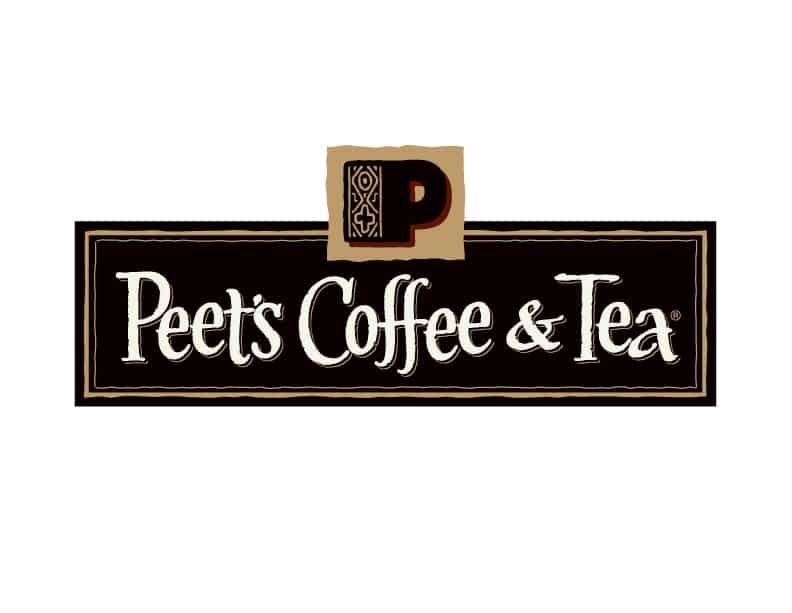
Peet shared his knowledge and specific style of coffee roasting with three friends. Then, in 1971, after working at Peet’s for a few weeks, they took their newfound skills and opened their own coffee house with Alfred’s blessing. You’ve probably heard of it. It started in Seattle.
That’s right.
The second wave of coffee can be defined by the rise of the coffee shop for the masses. Anyone can now enjoy a professionally brewed cup of coffee. And with the endless expansion of Starbucks and other coffee chains, they can enjoy it at every street corner.
But with this ever-expanding sprinkling of coffee shops around practically every city around the world, the newness and the uniqueness wears off. Enter the Third Wave of coffee.
The big coffee chains cater to the masses with drinks that are less and less about coffee and more and more about whipped cream and syrups. But a few (it’s always a few in the beginning) coffee shop owners took a different route. They focussed more on the quality of the coffee bean and perfecting the brew method. So the first Third Wavers put the coffee back on center stage.
Coffee is treated more and more like wine. Baristi and specialty coffee sellers can tell you exactly where the coffee comes from. What characteristics the flavor has due to environmental circumstances. And to the date when the coffee was roasted (and again, where). Tastings are organized, and tastes like citrus, chocolate, flowers, and earthy are now closely related to specialty coffee.
In the last ten years, this way of looking at coffee has become more mainstream. Specialty Coffee is labeled more like wine. Farm, harvest, coffee variety, processing method, roasting information (country, city, date), and flavor features are put on the bags. This is what consumers expect nowadays.
You might think this is it. We have reached the peak of conscious coffee consumption. When well-informed consumers care where their coffee comes from, how it is processed and roasted. Well, then we have reached a state of nirvana. Maybe not…
Specialty coffee has never been the exclusive domain of the coffee shop. An army of home brewers supported by a host of companies providing fancy gear has always existed. In recent years though, this army seems to be going one step further: home roasting. You can buy small quantities of green, unroasted coffee and use a popcorn popper, small roasting pan, or even a semi-professional coffee roaster to roast your own coffee. Truly fresh!
Let’s see where the fourth wave takes us.
So three (or four) waves of coffee.
Now you know what it is all about.
Commercialization, the rise of the coffee shop, and the emergence of the specialty coffee culture.
It’s nice to know these things.
For me, it means I understand my older relatives (they are in their sixties) a bit better. They don’t care about specialty coffee. They just want their regular cup of joe. Maybe that’s just because they drank it for longer than specialty coffee has been available.
I practically grew up with the good stuff.
Well, I am not that young, unfortunately, but you catch my drift.
Cheers!
Monsieur Coffee
MonsieurCoffee.com is a participant in the Amazon Services LLC Associates Program, an affiliate advertising program designed to provide a means for sites to earn advertising fees by advertising and linking to Amazon.com. We earn small commissions on purchase made through links on this site, at no extra costs to you.
Click Here to See How

Coffee is one of the most popular drinks in the world. The taste profile of coffee is usually associated with the four “basic tastes”: sweet,

I had a discussion with a friend the other day. He stated that coffee is actually a tea. I was dumbstruck. How can you say
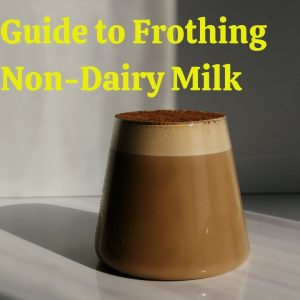
Non-dairy milk has been an excellent alternative to milk for many people. Can you use it to froth? Find out what types you can and can’t here.

The perfect start of the day involves a good cup of coffee for most people. I know it does for me! But if the coffee